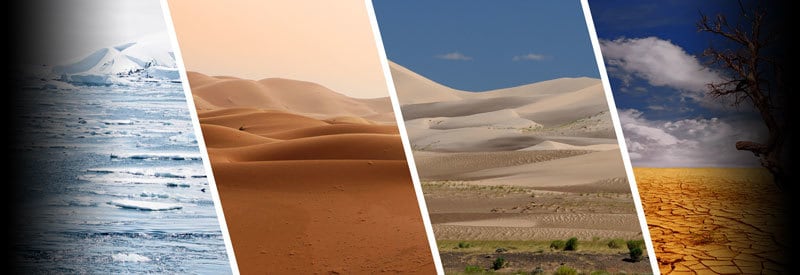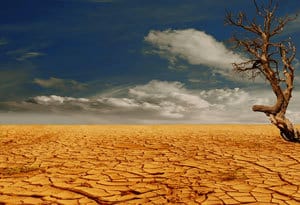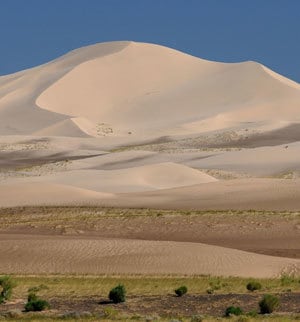What The Weather Is Like In A “Desert Climate”, And Why You Should Care

Since the late 19th Century, global temperatures have been steadily increasing, and with it, the size and number of deserts. As a result, the term "Desert Climate" has received a lot more attention recently.
A Desert Climate is defined as the average weather conditions in arid or semi-arid regions with little to no rainfall. It results from evaporation exceeding the amount of precipitation for extended periods. A region is classified as a desert when its annual rainfall is less than 25 cm or 9.8 inches.
One will be forgiven for thinking of a desert as a very hot and dry region with little or no weather activity. For the most part, you will be correct. If you don't live in an arid area, you won't even consider the fact that this growing phenomenon may impact you in any way.
But you are probably not seeing the whole picture. There is a reason why "desert climate" and "desertification" are terms more frequently used. And there is also a good reason why you should care.
This article explains what a "desert climate" is, the weather associated with it, and how this phenomenon is growing and may affect you.
An arid region is officially classified as a desert when it receives less than 25 centimeters (9.8 inches) of rain per year. The lack of moisture is the primary cause of why so little weather activity takes place and can be observed in a desert.
As you will soon find out, though, not all deserts conform to this conventional view you have of a typical desert. Neither does the weather always remain warm and dry, as you would expect in a desert.
There are two types of desert climate, and we need to take a closer look at each one to understand the extent to which deserts and the weather associated with them can differ:
1) Hot Desert Climate
Location
Deserts with hot climates can typically be found in the world's subtropical regions (between 30° North and 30° South). The world's biggest hot desert, the Sahara, can be found in Africa. Other examples include the Arabian Desert, the Arizona Desert, and the Great Victoria Desert.
Weather
To be classified as having a hot desert climate, an arid region must have a minimum annual temperature of at least 18° Celsius (64° Fahrenheit) and an annual rainfall of no more than 200 millimeters (7.9 inches).

The weather in a hot desert climate is, needless to say, very hot and dry. During summer months, average temperatures of above 30° Celsius are common, with many days exceeding 40° Celsius. Winter months are colder, but temperatures remain high.
A hot desert climate is also characterized by contrasting weather. This is evident in the stark difference between day and night temperatures. Warm days can quickly turn into cold evenings as soon as the sun goes down.
During winter months, it is not uncommon to experience a relatively warm day, while temperatures can drop to freezing point in the evening.
The low rainfall is largely due to the region's geology, marked by rocky and sandy terrain with sparse vegetation. This results in little moisture that can evaporate to form rainfall. High temperatures can also cause raindrops to evaporate before reaching the ground.
2) Cold Desert Climate
Location
Deserts with cold climates can usually be found at much higher altitudes than arid regions with hot desert climates. Hard to believe, but Antarctica is considered to be the coldest desert in the world due to the interior's average annual precipitation of less than 51 millimeters.
They can also be found in temperate zones, often on the leeward side of high mountains. The Gobi Desert in Mongolia is an example of such a desert. Other regions with cold desert climates include the Karagiye Depression, the Patagonian Desert, and the Great Basin Desert.
Weather
To be classified as having a cold desert climate, an arid region must have a maximum annual temperature of 18° Celsius (64° Fahrenheit) or below and a yearly rainfall of no more than 200 millimeters (7.9 inches).

As the name suggests, the weather in a cold desert climate is cold and dry. It is characterized by relatively warm summers but also very cold winters, unlike areas experiencing hot desert climates. (Although even the summers may be cold).
It also differs from a warm weather climate in the way precipitation takes place. The little precipitation that does occur is usually in the form of snow, not rain. (Especially in areas where the average annual temperature is below freezing point).
The Worrying Trend Of Desertification And Why You Should Care
It will be clear by now that regions with a desert climate experience harsh weather conditions and a very inhospitable environment. This makes it very difficult, even impossible, to use it for creating urban environments, as well as utilizing it for agriculture.
And this is the growing problem we are facing with desertification. But first, we need to know what desertification is.
What Is Desertification?

Desertification is the process through which fertile and habitable land is turned into a desert as a result of a loss of water, both on the surface and in the ground. The lack of water is closely followed by a loss of vegetation and wildlife. It is mainly a result of human activity.
Some of the leading causes include activities such as deforestation, the overuse of fertile soil, and other forms of overexploitation. Climate change (mainly due to global warming) is considered to be one of the leading causes.
Without getting into a debate about climate change, the fact that the earth is warming up at a rapid rate, and so is desertification as a result of it, is a worrying trend with potentially serious consequences. And this is why you should care, as the next session will illustrate.
The Serious Consequences Of Desertification
As stated before, the process of desertification is mostly a result of human activity. Natural changes in climate that occur over thousands of years, turning regions into deserts, rainforests, or swampland, are normal. What we are experiencing with desertification is not.
Land degradation (the deterioration of land to the point where it becomes worthless for any human use) is a consequence of desertification. According to National Geographic, 75% of the world's land is already degraded.
At the current rate at which desertification is taking place, the European Commission's World Atlas of Desertification estimates that more than 90 percent of global land may become degraded by 2050.
The consequences will be devastating, not just for the agricultural sector but for every human being on the planet.
The following is a list highlighting just some of the direct and indirect consequences and impacts of desertification:
- A dramatic decrease in available and viable land for agriculture.
- A steep rise in food prices is a result of a scarcity of produce.
- Urban areas in semi-arid regions will be confronted by increasing water shortages.
- Affected urban locations and metropolises will experience extreme weather, making living conditions much harder and influencing quality of life.
- The above-mentioned conditions will only worsen the effects of the urban phenomenon called the Urban Heat Island. You can read more about this occurrence here.
- Without vegetation that acts as a natural barrier that slows down and limits the extent of flooding, large parts of land are now more vulnerable to large-scale flooding.
- As more people move away from arid areas to locations with more favorable living conditions, overpopulation becomes a real danger.
Conclusion
Unfortunately, the growth of existing deserts and the emergence of new ones is a reality. So is the far-reaching consequence which will affect every one of us.
The goal of this article was not to spread paranoia. Its simple aim is to explain the growing climate pattern, known as Desert Climate, what it is, and why it is important. It also explains how it relates to desertification and helps you realize how it affects all of us in the long term.
Never miss out again when another interesting and helpful article is released and stay updated, while also receiving helpful tips & information by simply clicking on this link .
Until next time, keep your eye on the weather!
